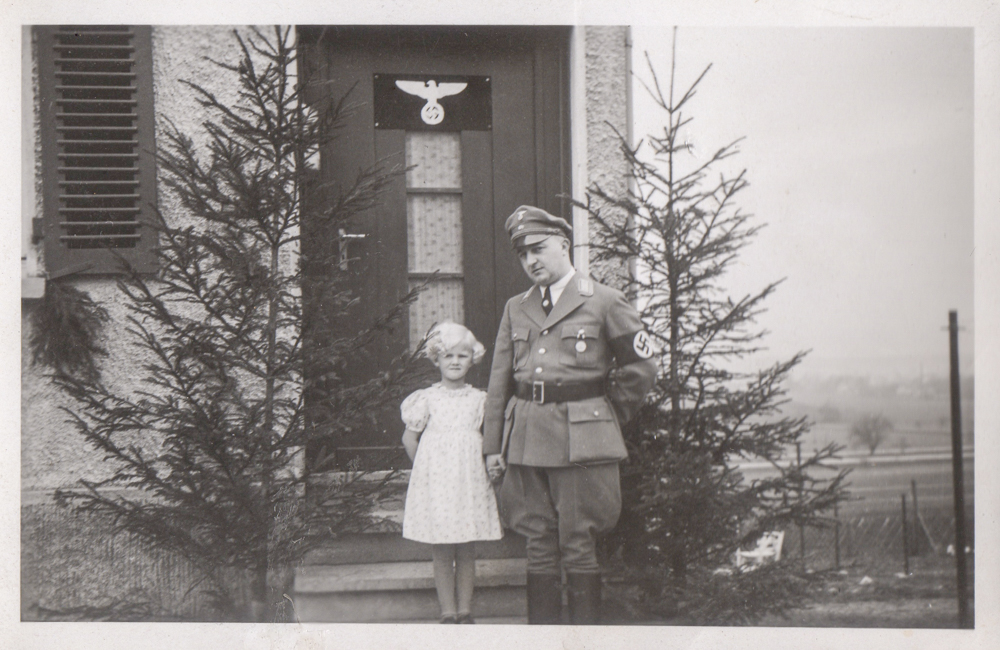March 7, 1945. My main activity in the Hitler Youth1 during the first two years was collecting all kinds of things. First of all, there was the Winter Relief Fund. I enthusiastically went out into the streets with my box full of boats, flowers, animals, little fairy tale books and whatever else there was to offer and sold them for quick money. A good corner on Augustusplatz2 [in Leipzig], on roller skates, in a smart uniform and with the much-loved light blonde hair that God gave me, and I had already fulfilled my quota in 1-2 hours. As a young person in those days, you felt so important. You were needed everywhere for the benefit of the fatherland, Goebbels called for people to eat stew, and of course I enthusiastically joined in and even spurned my pudding that my mother secretly put in front of me. The Führer had ordered that nothing should be wasted, and so our battle cry was: “Knochen, Lampen, Eisen und Papier, ausgeschlagen Zähne sammeln wir?”3

In a large apartment building with many tenants at home, I regularly knocked on doors and asked for newspapers, bones and lamps. If you reached a certain number of points with this old material after three months, you were awarded a book prize at school. 1 kg of rags brought the most points, but who would part with old things when everything was altered and worn again? Bones were also very rare, because meat rations were becoming increasingly scarce. So once a week I usually only lugged heavy newspapers to the collection point, which were not very highly rewarded. Chestnuts could also have helped me to win a book prize, but the few that I found in the parks around the Battle of the Nations Memorial, and for which I often had to fight with other children, also helped me to get free entry to the wonderful Leipzig Zoo. Its animals were even more important to me than the literature of the Third Reich that was promised. A short holiday in Silesia4 with my father helped me to stand on the podium as a collective winner for the only time.
I remember one last march through Sonneberg in full Hitler Youth uniform. The enemy armies were ready on the Rhine5 and in the middle of Pomerania6. The city was packed with refugees from the German eastern territories, and we were still yelling: “Wir marschieren für Hitler durch Nacht und durch Not”.7
In the past, the population had flown flags in our honour, but now the only noise they heard when they sang was that they slammed their windows shut, and my mother was glad that I came home safely from the procession. There was only one topic of conversation every day: how could we survive, and would the Americans take Thuringia first or would the Russians invade the country.
- The Hitler Youth was officially founded in 1926, with its roots tracing back to the early 1920s. It was initially part of the Nazi Party’s paramilitary organization, the SA (Storm Troopers). The movement aimed to recruit and train young Germans in Nazi ideology, preparing them for future roles in the party and military. By the time Hitler came to power in 1933, the organization had grown significantly, and by 1936, membership became mandatory for all “Aryan” children over the age of ten.
↩︎ - Augustusplatz is a well-known square in Leipzig, Germany. It is one of the largest public squares in Germany and has significant historical and cultural importance. Located at the eastern end of the city centre, Augustusplatz is surrounded by several notable buildings, including: Leipzig Opera House (Oper Leipzig), Gewandhaus (Home to the Gewandhaus Orchestra), Paulinerkirche (Pauline Church), City-Hochhaus Leipzig (A skyscraper also known as the “Uniriese” or “University Giant,” which offers a panoramic view of the city).
↩︎ - Bones, lamps, iron and paper, shall we collect knocked out teeth? The phrase “Knochen, Lampen, Eisen und Papier, ausgeschlagen Zähne sammeln wir” is historically linked to the waste collection and recycling efforts promoted by the Nazi regime, particularly through the Hitler Youth. This initiative was part of a broader strategy to mobilize resources for the war effort during World War II.
↩︎ - Silesia is a historical region in Central Europe that spans parts of modern-day Poland, Germany, and the Czech Republic
↩︎ - The American Army reached the Rhine River on March 7, 1945, at the town of Remagen, where they captured the Ludendorff Bridge, famously allowing American forces to establish the first significant Allied bridgehead across the Rhine. This event accelerated the Allied advance into the heart of Germany. Following Remagen, other crossings occurred as American and Allied forces moved across the Rhine in various locations, marking a significant breach of one of Germany’s last natural defensive barriers.
↩︎ - The Red Army reached Pomerania in early March 1945 as part of their broader offensive into eastern and northern Germany, capturing key cities like Stettin (now Szczecin, Poland) and reaching the Baltic coast, which isolated German forces in the area and effectively ended major military operations there.
↩︎ - The phrase “Wir marschieren für Hitler durch Nacht und durch Not” translates to “We march for Hitler through night and hardship,” and it reflects the indoctrination and militaristic culture fostered by the Hitler Youth during the Nazi regime. The Hitler Youth, or Hitlerjugend, was a crucial element of Nazi Germany’s strategy to mold the younger generation into loyal followers of Adolf Hitler and the National Socialist ideology.
↩︎